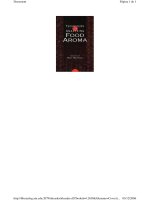Techniques for Engineering Decisions ValueatRisk or VaR
Bạn đang xem bản rút gọn của tài liệu. Xem và tải ngay bản đầy đủ của tài liệu tại đây (260.89 KB, 29 trang )
ECE 307 – Techniques for Engineering
Decisions
Value-at-Risk or VaR
George Gross
Department of Electrical and Computer Engineering
University of Illinois at Urbana-Champaign
© 2006 - 2009 George Gross, University of Illinois at Urbana-Champaign, All Rights Reserved.
1
INTRODUCTION TO FUTURES
Commodity traders trade important commodities
such as foodstuff, livestock, metals, fuel, and
electricity using financial instruments known as
forward contracts
Standardized forward contracts are known as
futures
© 2006 - 2009 George Gross, University of Illinois at Urbana-Champaign, All Rights Reserved.
2
INTRODUCTION TO FUTURES
Futures have finite lives and are primarily used
for hedging commodity price-fluctuation risks or
for taking advantage of price movements, rather
than for the buying or the selling of the actual
cash commodity
The buyer of the futures contract agrees on a
fixed purchase price to buy the underlying
© 2006 - 2009 George Gross, University of Illinois at Urbana-Champaign, All Rights Reserved.
3
INTRODUCTION TO FUTURES
commodity from the seller at the expiration of the
contract; the seller of the futures contract agrees
to sell the underlying commodity to the buyer at
expiration at the fixed sales price
As time passes, the contract's price changes
relative to the fixed price at which the trade was
initiated
This creates profits or losses for the trader
© 2006 - 2009 George Gross, University of Illinois at Urbana-Champaign, All Rights Reserved.
4
INTRODUCTION TO FUTURES
The word "contract" is used because a futures
contract requires delivery of the commodity in a
stated month in the future unless the contract is
liquidated before it expires
However, in most cases, delivery never takes
place
Instead, both the buyer and the seller, usually
liquidate their positions before the contract
expires; the buyer sells futures and the seller
buys futures
© 2006 - 2009 George Gross, University of Illinois at Urbana-Champaign, All Rights Reserved.
5
COMMODITY PORTFOLIOS
Traders usually hold portfolios of commodities; a
collection of different commodities, each bought
at a certain price, with different terms and
conditions
This is done in order to diversify the portfolio and
mitigate the overall risk
The value of a portfolio, at any given point in time,
is determined by the summation of the individual
values of each of the commodities in the ‘basket’
© 2006 - 2009 George Gross, University of Illinois at Urbana-Champaign, All Rights Reserved.
6
MARKET UNCERTAINTIES
We consider the purchase of a portfolio P at a
certain time t = 0 for the overall price p0
The value of the portfolio at any time t is pt
This portfolio is exposed to the various sources
of uncertainty to which the market for each
commodity is subjected and consequently its
value will fluctuate
© 2006 - 2009 George Gross, University of Illinois at Urbana-Champaign, All Rights Reserved.
7
PERFORMANCE PREDICTION
On any given trading day t = T, the fixed portfolio
may either incur a loss or a gain or remain
unchanged with respect to its value at t = T – 1
We wish to study what the worst performance of
the portfolio may be from the day t = T – 1 to the
day t = T and how to systematically measure the
performance
© 2006 - 2009 George Gross, University of Illinois at Urbana-Champaign, All Rights Reserved.
8
PERFORMANCE PREDICTION
At t = T, we cannot lose more than the overall
value p T of the portfolio and this statement is
true with a probability of 1
In other words, with a probability of 1, the loss
must be less than or equal to p T
© 2006 - 2009 George Gross, University of Illinois at Urbana-Champaign, All Rights Reserved.
9
PORTFOLIO VALUE AND RETURNS
We evaluate the change δ t in the portfolio close
value p t from t = T – 1 to t = T as:
δ T = p T – p T–1
We define the rate of return r t of the portfolio from
t = T – 1 to t = T in terms of δ T to be
rT =
δ
T
p T −1
© 2006 - 2009 George Gross, University of Illinois at Urbana-Champaign, All Rights Reserved.
10
PORTFOLIO VALUE AND RETURNS
The value of r t for each observation is the change
in the portfolio value from day t = T – 1 to day t = T
The value of r t must lie in the interval [-1, ∞)
A non-positive value of r t means there is a loss
in the portfolio value from t = T – 1 to t = T
© 2006 - 2009 George Gross, University of Illinois at Urbana-Champaign, All Rights Reserved.
11
DATA COLLECTION
Suppose that we have the set of data for r T
We are sampling from a population, the
realizations of the random variable P with values
{ p 0 , p 1, … , p T – 1, p T , … }
We use P to define Δ and R
The sample values of R are { r 1, r 2, … , r T – 1, r T , …}
© 2006 - 2009 George Gross, University of Illinois at Urbana-Champaign, All Rights Reserved.
12
DATA COLLECTION
P
date
close price
loss/gain
percent loss/gain
3/5/2007
$42.15
-$0.33
-0.78%
3/2/2007
$42.48
-$0.65
-1.51%
3/1/2007
$43.13
-$0.20
-0.46%
2/28/2007
$43.33
$0.14
0.32%
2/27/2007
$43.19
-$1.85
-4.11%
.
.
.
.
.
.
.
.
.
.
.
.
3/18/1999
$105.12
$2.00
1.94%
3/17/1999
$103.12
-$0.75
-0.72%
3/16/1999
$103.87
$0.87
0.84%
3/15/1999
$103.00
$2.88
2.88%
3/12/1999
$100.12
-$2.50
-2.44%
3/11/1999
$102.62
$0.50
0.49%
© 2006 - 2009 George Gross, University of Illinois at Urbana-Champaign, All Rights Reserved.
R
Δ
13
DATA COLLECTION
p3/1/2007
date
close price
loss/gain
percent loss/gain
3/5/2007
$42.15
-$0.33
-0.78%
3/2/2007
$42.48
-$0.65
-1.51%
3/1/2007
$43.13
-$0.20
-0.46%
2/28/2007
$43.33
$0.14
0.32%
2/27/2007
$43.19
-$1.85
-4.11%
.
.
.
.
.
.
.
.
.
.
.
.
3/18/1999
$105.12
$2.00
1.94%
3/17/1999
$103.12
-$0.75
-0.72%
3/16/1999
$103.87
$0.87
0.84%
3/15/1999
$103.00
$2.88
2.88%
3/12/1999
$100.12
-$2.50
-2.44%
3/11/1999
$102.62
$0.50
0.49%
© 2006 - 2009 George Gross, University of Illinois at Urbana-Champaign, All Rights Reserved.
r3/1/2007
δ3/1/2007
14
DATA COLLECTION
We can use the historical values of R to construct
a probability distribution function
The first step is to determine the frequency of R
taking on values in certain intervals; for this
purpose, we discretize R and define ‘buckets’ in
which we drop the realized values of R
The number of values in each bucket represents
the frequency of R taking on a value in that
bucket
© 2006 - 2009 George Gross, University of Illinois at Urbana-Champaign, All Rights Reserved.
15
BUCKETS AND FREQUENCY
buckets
frequency
-10.00 %
-9.75 %
0
0
-9.50 %
-9.25 %
1
0
.
.
.
.
-0.50 %
-0.25 %
118
140
0.00 %
0.25 %
0.50 %
158
146
160
.
.
.
.
19.25 %
19.50 %
19.75 %
20.00 %
0
0
1
0
© 2006 - 2009 George Gross, University of Illinois at Urbana-Champaign, All Rights Reserved.
16
frequency
FREQUENCY VS. RETURNS
DISTRIBUTION
returns
© 2006 - 2009 George Gross, University of Illinois at Urbana-Champaign, All Rights Reserved.
17
NORMALIZATION
We normalize these frequencies using the total
number of observations and interpret the
normalized quantities as the values of a discrete
probability mass distribution function
We then construct the cumulative distribution
function from this data, and interpret the results
with respect to the returns
© 2006 - 2009 George Gross, University of Illinois at Urbana-Champaign, All Rights Reserved.
18
normalized frequency
NORMALIZED FREQUENCY
DISTRIBUTION
returns (%)
© 2006 - 2009 George Gross, University of Illinois at Urbana-Champaign, All Rights Reserved.
19
CUMULATIVE DISTRIBUTION
FUNCTION (CDF)
this CDF gives the
cumulative values
1. 0
0. 9
0. 8
of probability
P{ R ≤ r} = y
example:
probability (y)
0. 7
0. 6
0. 5
0. 4
0. 3
0. 2
P{ R ≤ - 2.25 %} =
0. 1
- 2.25 %
0.
20
0.
16
0.
12
0.
08
0.
04
0.
00
-0
.0
4
-0
.0
8
0.1
-0
.1
2
0. 0
returns
© 2006 - 2009 George Gross, University of Illinois at Urbana-Champaign, All Rights Reserved.
20
INTERPRETING THE CDF
We consider the data set to be a representative of
the distribution of the population of trading days
In the previous example, “the probability that R
is less than or equal to - 2.25 % is 0.1”
By treating the complement of the probability
value (0.1) as a “confidence level” (0.9), the above
may be restated as “with a confidence level of 0.9,
R will exceed - 2.25 %”
© 2006 - 2009 George Gross, University of Illinois at Urbana-Champaign, All Rights Reserved.
21
UNDERSTANDING THE CDF
In general, for any confidence level (1-y), the
information provided by the CDF allows us to
determine the value r that R exceeds based on
the observations in the collected data
For example, with a 0.95 confidence level, it
follows from the CDF that R exceeds - 3.44 %
We can interpret this to mean that with a
confidence level of 0.95 we don’t expect to lose
more than 3.44 % in the worst case
© 2006 - 2009 George Gross, University of Illinois at Urbana-Champaign, All Rights Reserved.
22
CUMULATIVE DISTRIBUTION
FUNCTION (CDF)
1. 0
0. 9
0. 8
0. 7
0. 6
0. 5
0. 4
0. 3
0. 2
0. 1
- 3.44 %
0.
20
0.
16
0.
12
0.
08
0.
04
0.
00
-0
.0
4
-0
.0
8
0. 0
-0
.1
2
probability (y)
with a
confidence
level of 95 %
we don’t
expect to lose
more than 3.44
% in the worst
case
returns (%)
© 2006 - 2009 George Gross, University of Illinois at Urbana-Champaign, All Rights Reserved.
23
VALUE-AT-RISK (VaR)
Terminology: “With a confidence level of 0.95, the
VaR on any one trading day is - 3.44 %” means
that with a 0.95 percent confidence level, the
return over two days cannot be below - 3.44 %
A negative VaR, say ν < 0, means that the losses on
any one day cannot be greater than - ν %
VaR is a measure, of the return which would be
exceeded based on the observations available
for the given time period, with the specified
confidence level
© 2006 - 2009 George Gross, University of Illinois at Urbana-Champaign, All Rights Reserved.
24
CUMULATIVE DISTRIBUTION
FUNCTION (CDF)
1. 0
0. 9
0. 8
with a confidence
level of 0.95, the VaR
on any one trading
day is - 3.44 %
0. 6
0. 5
0. 4
0. 3
0. 2
0. 1
-3.44%
0.
20
0.
16
0.
12
0.
08
0.
04
0.
00
-0
.0
4
-0
.0
8
0. 0
-0
.1
2
probability (y)
0. 7
returns (%)
© 2006 - 2009 George Gross, University of Illinois at Urbana-Champaign, All Rights Reserved.
25









